This post may contain affiliate links. See our disclosure policy.
It’s always good to have a surplus of food on hand for those “what if” situations. But knowing what to buy and where to store food you buy can be a challenge. Here we break down why it’s important to have food storage and some easy storage solutions for your home.
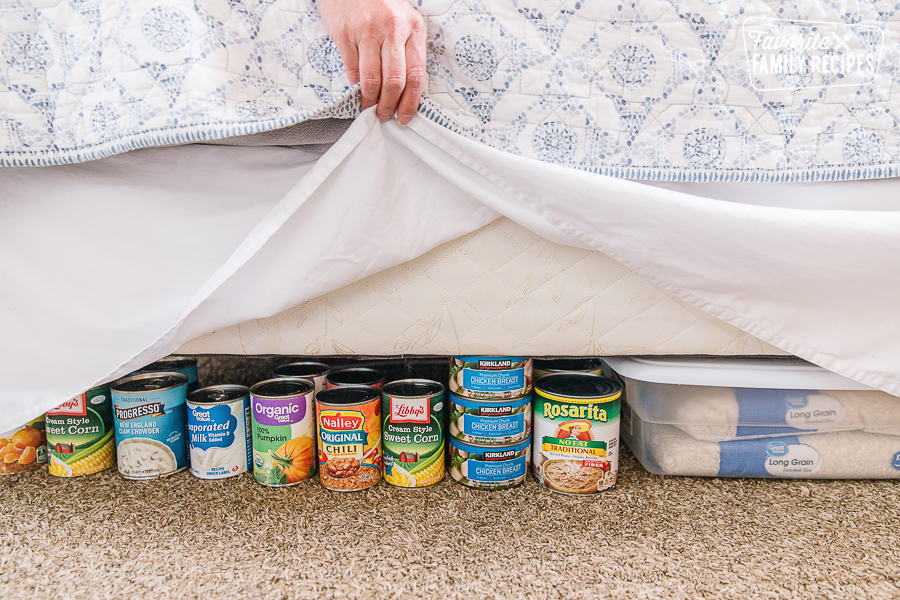
Featured With This Post
Why Store Food?
This post is not meant to scare or add extra stress to your life. Our goal is to help you feel prepared so you have peace of mind if and when the time comes that life-as-usual becomes disrupted. Obviously the Coronavirus (COVID-19) has everyone on edge and thinking about what would happen if food or supplies (I’m looking at you, toilet paper) were scarce. There are several reasons why it’s a good idea to keep extra food and supplies on hand:
- Natural Disasters or Emergencies: A few years ago, some friends of ours in Houston were trapped in their neighborhood for days due to flooding. Food storage came in handy for those several scary days for them, as they were able to take care of their family and neighbors with what they had in their home. Natural disasters such as tornadoes, floods, earthquakes, hurricanes or winter storms can keep you from getting the supplies your family needs.
- Loss of a Job or Economic Crisis: The likelihood of needing to tighten the budget is much higher than a water shortage or natural disaster. While a natural disaster or pandemic is a big reason most people start building food storage, loss of a job or a national economic crisis is what will keep the idea of food storage going. The future is uncertain, and it’s comforting to have a plan in place for a time you may have to live off what you have stored.
- Operating on a Strict Budget: When money is tight, storing extra food can actually end up saving you money in the long run. Cooking with pantry staples from scratch, not buying as much produce and always shopping when things are on sale are just a few ways food storage can help you stretch your dollar when money is tight for your family
- Everyday Emergencies: Have you ever been in the middle of a recipe and realize you’re out of baking soda or sugar? While you may not consider that an “emergency” situation, having some food storage accumulated is a helpful benefit for moments like this. Whether you don’t have time to shop, you have a last minute food assignment for a party, or you need a quick dinner, dipping into that food storage can save you lots of time and money and give you peace of mind.
For a quick, inexpensive, and easy way to start food storage, see our FREE 14-Day Meal Plan and Shopping List using all non-perishable foods.
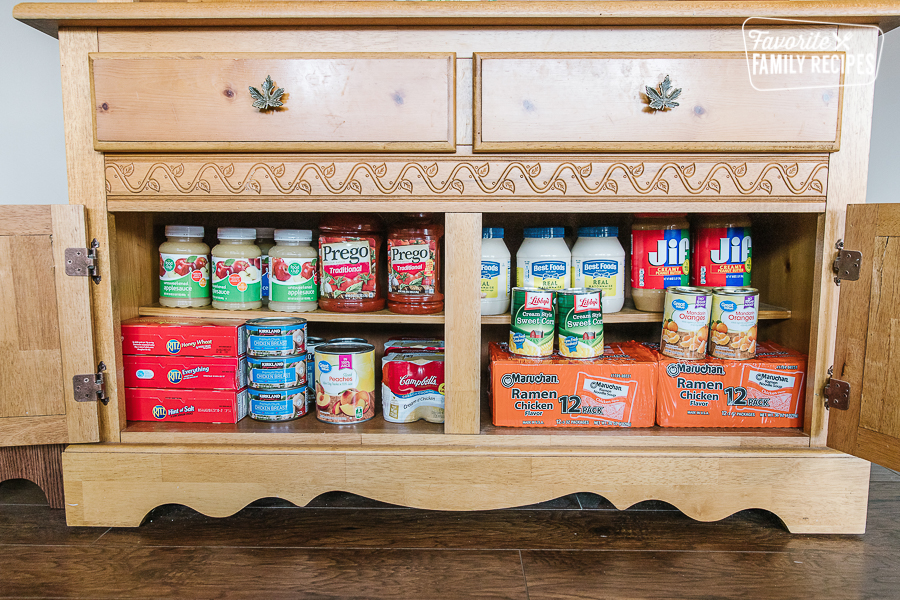
9 Spaces to Store Food in Your Home
A big reason why many people shy away from food storage is that they simply don’t have the space for it. If you don’t have a huge pantry or basement in your home, you can still find clever ways to store food and other supplies. With these ideas however, it’s important to plan and prepare a place to store some of the more common food in your house where it can be easily accessible for rotation purposes.
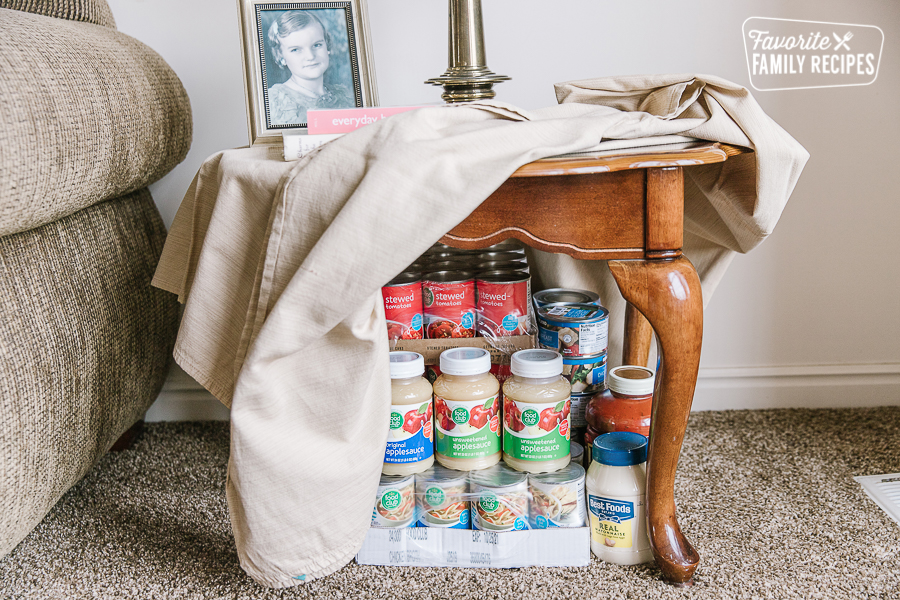
- Coat Closets: If you have a coat closet that just seems to gather junk rather than coats, this is a perfect spot to start. Invest in a coat rack to put near your front door. Then you can stack cases of food or water or create shelves for other items. Or keep the coats and utilize the floor space or the higher shelves.
- Vertical Space: Line the bottom of a broom closet, linen closet or kids’ closets with cans of the same height, then cover with a piece of plywood to create a faux floor. That way your kids can still stack their shoes and things on the plywood and never even be bothered by the food hidden beneath.
- High Closet Shelves: If your kids have closets with high shelves, chances are they don’t use it very much. This is a terrific option for storing toiletries and cleaners so they are safely out of your child’s reach.
- Under the Bed: This is a perfect place to store food that you want out of the way, but still accessible to use. Line the edges of the bed with boxes of food that you use regularly, then rotate through so nothing goes to waste.
- Faux Walls or Behind Furniture: If you have a large dining room, bedroom or even bathroom, you can hang a decorative curtain or add a screen a few feet out from the wall, where you can store canned goods, boxes of food or other things behind. That way you can store extra items and still make the room look pretty.
- Food Storage Furniture: Stack boxes of food together, cover with fabric or a table cloth and turn it into an end table, TV stand or coffee table. Make nightstands in your bedroom or a window seat out of sturdy boxes containing large canned goods or other bulky items.
- Open Shelving with Decorative Containers: Items like rice, flour, wheat and beans look pretty when stored in decorative jars. If kitchen or dining room walls have extra space, build some simple open shelves (2×4 boards and easy brackets do the trick) and line them with Mason jars or other pretty containers.
- Space Above Kitchen Cabinets: If your cabinets have a few feet of space between them at the ceiling, you can store foods like pasta, soup mixes and other dried foods. They’ll stay nice and dry up there and you can use decorative containers to make it look pretty.
- Garage, Attic or Crawl Space: You’ll have to be careful about storing food in places that aren’t temperature controlled, but an attic, garage or a crawl space could be perfect for toilet paper, paper towels, water, cleaners and other items.
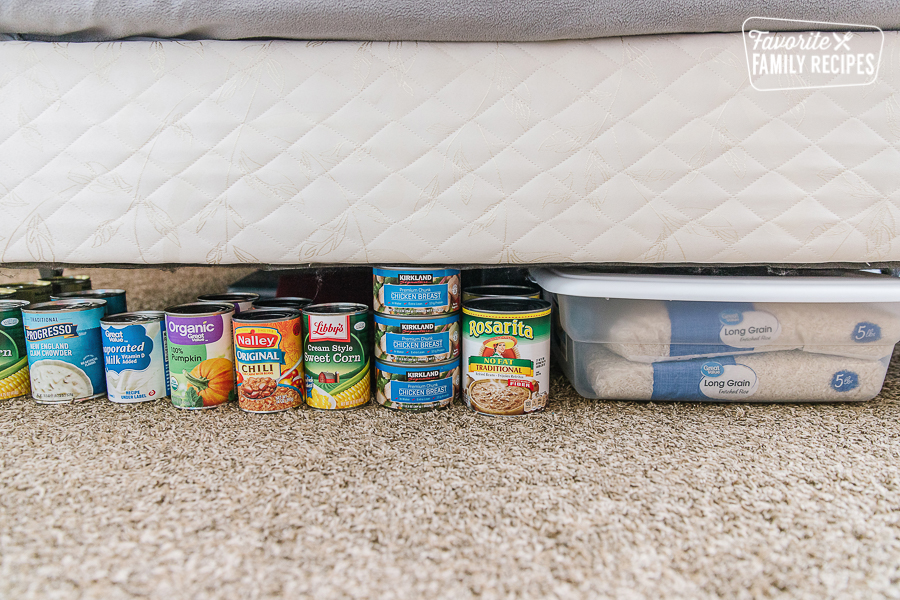
Important Food Storage Tips
When storing foods on the floor in closets, under beds, under end tables, etc, there are important things to consider. It is an investment of money, time, and energy to store food and you will want to make sure it stays safe. Please keep the following tips in mind:
- Only store food on the floor that is canned or bottled in PETE plastic. Store glass containers on shelves or in cupboards.
- Store food in a cool, dry, and dark place that is free from bugs and/or rodents. It is recommended that food is stored in temperatures at or below 75 degrees.
- Place a barrier between the food and the flooring, especially in areas with high humidity. A piece of cardboard or a wood slat will protect food from moisture. If food is already boxed or in a plastic container, it should be fine.
- Do not store food on concrete. Concrete changes temperatures quickly and gives off moisture.
- Food that is purchased in plastic bags or boxes, should be stored in a bin with a lid or sealed box (as pictured below). This protects the food from rodents and bugs. It also protects pets and small children from eating something that would cause a choking hazard or be harmful in any way.
- Keep a list of where your food is stored. Write a note in your phone or stick a list on the fridge. You will want to keep track of which foods are stored where. This will keep you organized so you can find ingredients when you need them.
How high off the floor should food be stored?
Most foods should be stored at least 6″ off the floor according to the FDA food code for restaurants. For food storage we recommend the same for many foods including food in bags, cardboard boxes, etc. For example, if you were to have flooding, what would be damaged if it got wet? If food is stored in large, lidded plastic containers that are resting on the floor you should be fine. We will oftentimes put canned food at the floor level since water won’t harm it. We will try to put a small barrier between the floor and the canned items so the floor doesn’t get damaged.
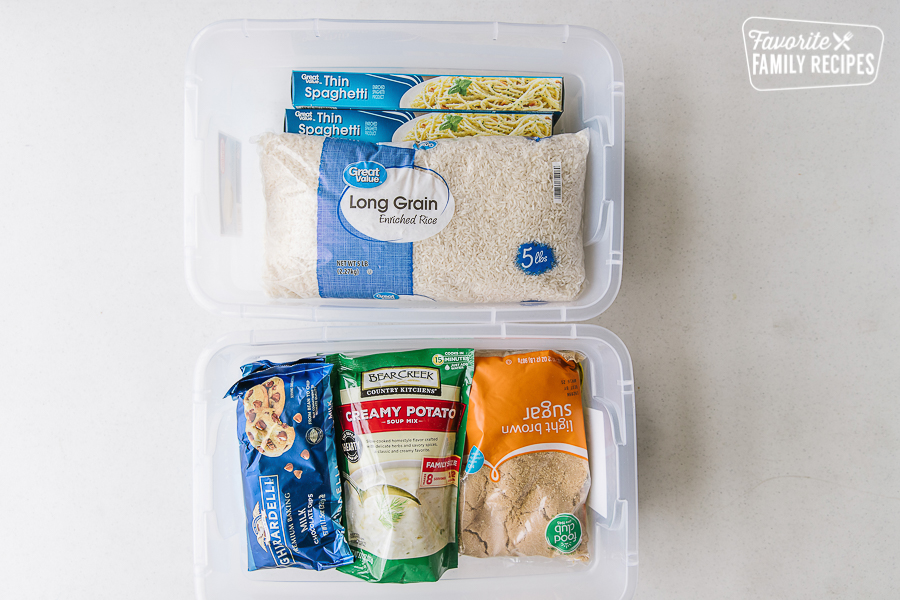
Don’t Forget to Rotate
Check the shelf life of your storage items and rotate food as needed. If you are really organized, you can keep a binder with an inventory of all your items and when they expire. We like to use most of our items that are getting close to the expiration date before they actually expire.
For a quick, inexpensive, and easy way to start food storage, see our FREE 14-Day Meal Plan and Shopping List using all non-perishable foods.
Questions About Storing Food
Food storing is basically planning for food emergencies by buying excess food items and storing them long term.
Any foods that are non-perishable with a long shelf life. This includes canned food, grains, dried foods, etc. For more details on what to store and how long to store in, check out out post on Long Term Food Storage.
According to “the Healthy Journal”, the two foods that you can survive on are eggs and potatoes. For food storage purposes, both of these food items can be bought as dehydrated foods and simply re-hydrated with hot water.
We have horribly inadequate cabinets in our house that was built in 1964. My husband repurposed someone else’s kitchen cabinets and hung them in our garage. Some of it has paint and men’s kind of stuff along with extra foil and zip lock bags, but another large one is our pantry. I am going to use the under the bed thing! We have 3 beds in the house. Mine already has my shoes in an under the bed drawer on my side, but DH’s side is empty! Then we have two queen sized beds. One bed has about half filled with my quilting fabric, but there is more room under there and the third one has a table under it that I could put canned food on! Now I just have to inventory and make sure I don’t forget what’s under there!
You are lucky to have a husband who can do that for you! Necessity IS the mother of invention, right? It just takes some imagination and determination. You are absolutely right about keeping an inventory. A simple spreadsheet or even notebook will work. Thank you for your comment!